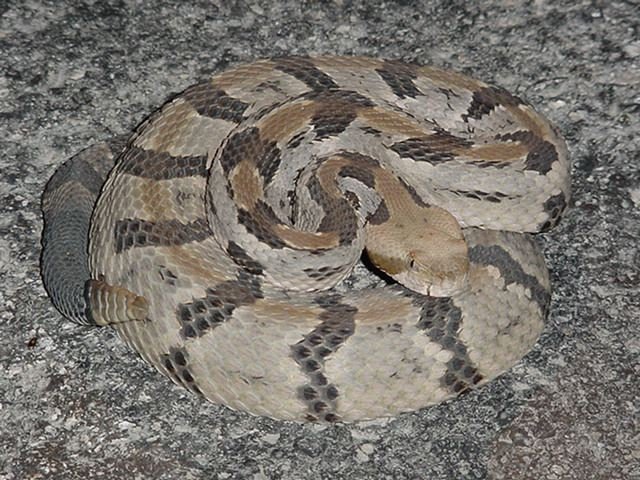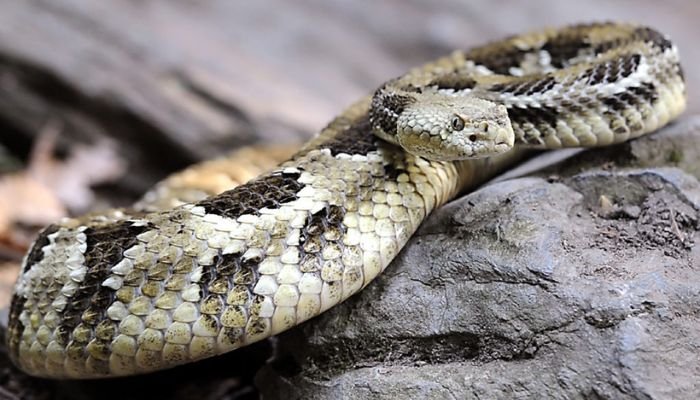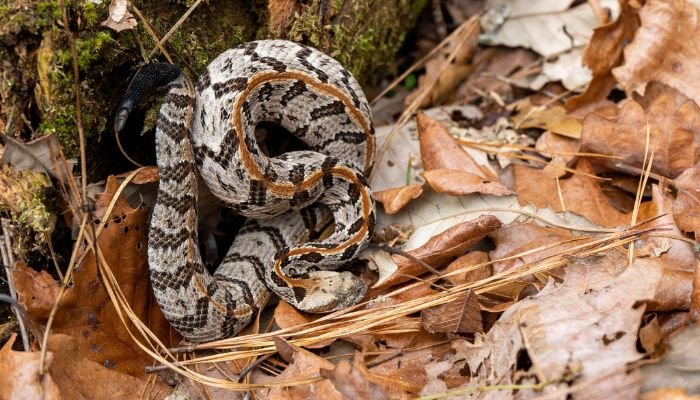
The North American Timber Rattlesnake is a species of poisonous snake. It is characterized by its distinctive vibration and intricate skin patterns. These snakes prefer to inhabit forested regions, where they serve as both prey and predators. Even though they are poisonous, they typically avoid human contact. Their populations are unfortunately gravely imperiled by habitat loss and illegal collection.. Here are Timber rattlesnake Guide on Food, Habitat, Size, Lifespan & Predators below-
Timber rattlesnake Stats in Table format
The stats are given below for Timber rattlesnake
| Reptiles List | Timber rattlesnake |
|---|---|
| Family | Viperidae |
| Type | Snake |
| Size | Medium to Large |
| Length | Timber rattlesnake: Up to 3-5 feet (0.9-1.5 meters) |
| Color | Timber rattlesnake: The color varies depending on the subspecies, but timber rattlesnakes can have shades of brown, gray, or black with darker markings. |
| Weight | Timber rattlesnake: The weight varies depending on the species, but most timber rattlesnakes weigh between a few ounces to a few pounds.. |
| Lifespan | 15-25 years (or more) |
| Reproduction | Ovoviviparous, gives birth to live young |
| Gestation Periods | Gestation period: Timber rattlesnakes do not have a gestation period as they are ovoviviparous, meaning the eggs develop and hatch inside the female’s body before giving live birth. |
| Endangered Status | Least Concern (IUCN Red List) |
| Features | Rattle on the tail, venomous bite |
| Country & Areas | United States (specifically found in the eastern and central regions, including parts of New England, the Midwest, and the Southeast) |
Timber rattlesnake Natural Habitat and Distribution
Venomous and widespread from southern New England to Florida and west to Texas, the Timber Rattlesnake (Crotalus horridus) is a common eastern snake. Its preferred habitat is thick undergrowth and rocky outcrops, and its native range encompasses deciduous forests, mixed woodlands, and wooded mountains. Hilly areas, valleys, riverbanks, and rocky outcroppings and crevices provide ideal habitat for these snakes because of the food and cover they offer.
Timber Rattlesnake Physical Features and Adaptations
Here are some information about timber rattlesnakes:
1. Body Structure
Adult timber rattlesnakes can grow to be between 3 and 5 feet (90 and 150 cm) in length. They have a powerful, musculatured body and a triangular head with poisonous fangs for biting into its victim.
2. Coloration and Patterns
They come in a wide range of colors, but all share a sequence of dark, contrasting crossbands that run the length of their bodies on a background that is typically gray, yellow, brown, or olive. These crossbands frequently appear in shades of rust or reddish brown. When threatened, they employ the tail’s rattle—a collection of interlocking segments—to make a rattling sound.

3. Defense Mechanisms
The Timber Rattlesnake relies mostly on its poisonous bite as a means of self-defense. Whenever it feels threatened, it will shake its tail to scare away predators and humans alike. It may bare its teeth and inject poison into its prey or imagined threat if the warning is ignored.
Timber Rattlesnake Diet and Feeding Habits
Here are some informations about Timber Rattlesnake Diet and Feeding Habits
1. Diet Type
Carnivorous and preying on mice and other small mammals, Timber Rattlesnakes are a common sight in the wild. They use their highly developed heat-sensing pits to locate their prey in the dark and then ambush it.
2. Preferred Food Sources
Mice, rats, voles, squirrels, and even birds and small reptiles are among their favorite foods.
3. Feeding Schedule
Sit-and-wait predators, Timber Rattlesnakes eat when there is an abundance of suitable prey in their environment. They may go weeks without eating after a good hunt.
Timber Rattlesnake Housing and Enclosure Requirements
Here are some information about Timber Rattlesnake Housing and Enclosure Requirements
1. Terrarium Size and Setup
Timber rattlesnakes need to be housed in cages that can not be broken into or climbed out of. For the snake’s own safety and comfort, the terrarium should be at least two-thirds the length of the snake. The mental health of a snake depends on its access to hiding places, such as rock fissures or constructed caves.
2. Substrate Options
Aspen shavings, cypress mulch, and newspaper are all good substrate choices. These substrates offer a soft landing spot for the snake and are simple to clean.
3. Temperature and Lighting
A temperature differential within the habitat is necessary for the survival of Timber Rattlesnakes. The temperature in the basking area of the terrarium should be between 85 and 90 degrees Fahrenheit (29 and 32 degrees Celsius), while the other side should be between 75 and 80 degrees Fahrenheit (24 and 27 degrees Celsius). The snake’s circadian rhythm requires a day-night cycle and bright, consistent lighting.
4. Humidity and Water Needs
The ideal relative humidity inside the cage is between 50 and 60 percent. The snake may drink from and shed in a small water dish, so make sure it has enough room to fully submerge itself.
Timber Rattlesnake Behaviour and Temperament
Here are some information about Timber rattlesnake Behaviour and Temperament
1. Activity Levels
Timber, Generally speaking, rattlesnakes are nocturnal, or active largely at night. They evade predators and conserve energy by spending the daytime hours concealed in thick foliage or rock crevices.
2. Social Behaviour
Because of their solitary nature, rattlesnakes are rarely seen in groups. Nonetheless, males are more likely to seek out females during the breeding season.
3. Handling and Taming
Due to its poison, Timber Rattlesnakes should not be handled. Only qualified experts should do tasks involving these snakes, such as medical examinations.
Timber rattlesnake Breeding and Reproduction
Here are some information about timber rattlesnake Breeding and Reproduction
1. Mating and Courtship Rituals
Timber As soon as rattlesnakes emerge from hibernation in the spring, mating season begins. Male snakes may fight each other over mating rights. A ritualized courtship dance may take place once a guy has successfully courted a female.
2. Incubation and Hatchlings
Females reproduce by giving birth to live offspring instead of depositing eggs. Females have a 5- to 6-month gestation period and can have anywhere from 5 to 20 babies. Baby snakes are self-sufficient and look like cute little grownups.
Timber Rattlesnake Common Health Issues and Veterinary Care
Here are some information about Timber rattlesnake Common Health Issues and Veterinary Care
1. Respiratory Infections
Inadequate husbandry or housing circumstances can lead to respiratory diseases in timber rattlesnakes, as is the case with all reptiles.
2. Parasites:
The health of timber rattlesnakes is at risk from parasites. Internal parasites can only be diagnosed and treated with regular fecal exams.
3. Metabolic Bone Disease
Metabolic bone disease can develop in captive snakes due to a lack of calcium and vitamin D. Preventing this disease requires a healthy diet and access to sufficient UVB lighting.
Importance of Regular Vet Check-ups
Captive timber rattlesnakes require routine veterinary care to ensure their health and longevity. If you want your snakes to survive while you keep them as pets, it is important to have regular checkups with a vet that specializes in caring for reptiles.

Facts
- The presence of timber rattlesnakes is often used as a barometer for the vitality of forest ecosystems.
- Large birds of prey like hawks and owls, as well as certain mammalian predators, are the greatest threats to Timber Rattlesnakes.
- In order to preserve heat and stay alive over the winter, Timber Rattlesnakes go into hibernation.
- Multiple snakes may use the same den (called a hibernacula) to rest throughout the winter.
- Rather than actively engaging potential predators, these snakes typically retreat.
- They may act defensively by doing things like coiling their tails and vibrating them to make a rattling sound if they feel threatened.
- Due to worries over dwindling populations and habitat loss, Timber Rattlesnakes are protected in numerous states.
- Despite this safeguard, they are nevertheless vulnerable to dangers like habitat loss, road deaths, and poaching.
- Timber rattlesnakes have both spiritual and cultural significance in Native American religions and mythologies.
- Depending on conditions, a wild Timber Rattlesnake might live anywhere from 10 to 20 years.
- Ecdysis, or the process of shedding the skin, is a normal part of a snake’s life cycle that aids in growth and the elimination of parasites.
- The heads of Timber Rattlesnakes are equipped with heat-sensitive pits that aid in the detection of their warm-blooded prey.
- When temperatures are mild in the spring and fall, the snakes are more likely to be active during the day.
- They become more nocturnal in the summer to escape the heat of the day.
- Timber While most rattlesnakes will avoid direct conflict with people, a cornered or threatened snake could strike.
- Depending on the size and nature of their prey or threat, they can adjust the amount of venom they inject.
- Timber rattlesnakes may gather at special spots to soak up the sun together.
- In order to detect prey and possible mates, Timber Rattlesnakes utilize their forked tongues to capture scent particles from the air.
- The species prefers the protection and sun exposure that rocky outcrops, ledges, and crevices can offer.
- As a sluggish moving snake, the Timber Rattlesnake relies on its camouflage to avoid being seen by potential predators and prey.
- Because of their shy disposition, seeing a Timber Rattlesnake in the wild is an extraordinary experience for many individuals.
- Keratin, the same protein found in human fingernails, is used to make the famous rattle on a snake’s tail.
- Like a fingerprint, each Timber Rattlesnake has a distinctive rattle sound.
- Despite their poison, these snakes prefer to avoid confrontation and usually flee when they encounter a larger predator.
- Depending on their environment, Timber Rattlesnakes can have a range of distinct colors.
- This species is protected worldwide thanks to its inclusion in Appendix II of CITES, the Convention on International Trade in Endangered Species of Wild Fauna and Flora.
- The illicit pet trade and human encroachment on their natural habitats are additional dangers to these reptiles.
- Timber rattlesnakes have pivotal roles as both predators and prey in their ecosystems.
- The survival of Timber Rattlesnakes for future generations to admire and study is dependent on our conservation efforts.
Conclusion
The Timber Rattlesnake, native to the eastern United States, is an interesting but possibly lethal reptile. Due to the difficulty in handling a venomous snake, keeping one is not suggested for anyone without prior knowledge. The health and well-being of these amazing snakes in captivity depend on adequate housing, nourishment, and frequent veterinarian treatment.
FAQs
Q: What is the family and Type of Timber rattlesnake?
The Timber rattlesnake, or Crotalus horridus, is a member of the viper family.
Q: What is the average size of a Timber rattlesnake?
Timber rattlesnakes range in length from about 91.5 to 152 cm (36 to 60 inches).
Q: How long can a Timber rattlesnake grow in size and length?
You should expect to see a timber rattlesnake between 91 and 152 centimeters in length, as they can grow to be 36 inches long.
Q: What colors do Timber rattlesnake s come in?
The background hue of a timber rattlesnake is often a light brown or grayish color, while the snakes have dark brown or black crossbands. It is possible for the crossbands to be replaced by blotches, and for there to be a rust-colored line running down the middle of the back.
Q: How big can a Timber rattlesnake get in weight?
The average weight of a timber rattlesnake is 2.2 pounds (5.5 kilograms).
Q: How long do Timber rattlesnakes live?
In the wild, timber rattlesnakes have a life expectancy of 10–20 years.
Q: How do Timber rattlesnakes give birth?
Yes, timber rattlesnakes do give birth to live offspring (they are ovoviviparous). They incubate the eggs inside of them until the time is right, at which point they deliver the newborn snakes alive.
Q: How long is the gestation period for a Timber rattlesnake?
Timber rattlesnakes, according to the answer key, take about 5–6 months to become pregnant.
Q: Is the Timber rattlesnake endangered?
Timber rattlesnakes are not globally endangered, although their conservation status varies by region. However, habitat degradation and human impact may cause them to be designated as threatened species in some states or regions.
Q: What are the prey of Timber rattlesnakes?
Small animals including mice, rats, squirrels, chipmunks, and rabbits are the staple diet of the timber rattlesnake. They also occasionally feed on other snakes and birds.
Q: Do Timber rattlesnake have any Predators?
Young Timber rattlesnakes may be preyed upon by larger birds of prey, animals, and even other snakes, but adult rattlesnakes have few natural predators due to their venom.
Q: How Fast Does Timber Rattlesnake Move?
Timber rattlesnakes, on the other hand, are notoriously slow. Because of their poor speed, these snakes must rely on disguise and ambush to successfully hunt.
Q. What is the Bite Force of Timber rattlesnakes in PSI?
There are no accurate measurements of the bite force of Timber rattlesnakes in pounds per square inch (PSI). On the other hand, their fangs are equipped with lethal poison that they use to kill their prey.
Q. Can we keep Timber rattlesnakes as pets?
Timber rattlesnakes are not advised as pets and are typically prohibited to own in many parts of the world. Venomous snakes pose a risk to anyone handling them without the right training and licenses.
Q. Are Timber rattlesnake s good for pest control?
Timber rattlesnakes prey mostly on small mammals like mice and rats, therefore in their natural environments they can help keep rodent populations in check. Keep in mind that they are still wild animals and not a replacement for standard pest management methods.
Q. Do Timber rattlesnake s require a UVB light source?
I hope you like reading on Timber Rattlesnake FAQ Guide on Food, Habitat, Size, Lifespan, and Predators.
